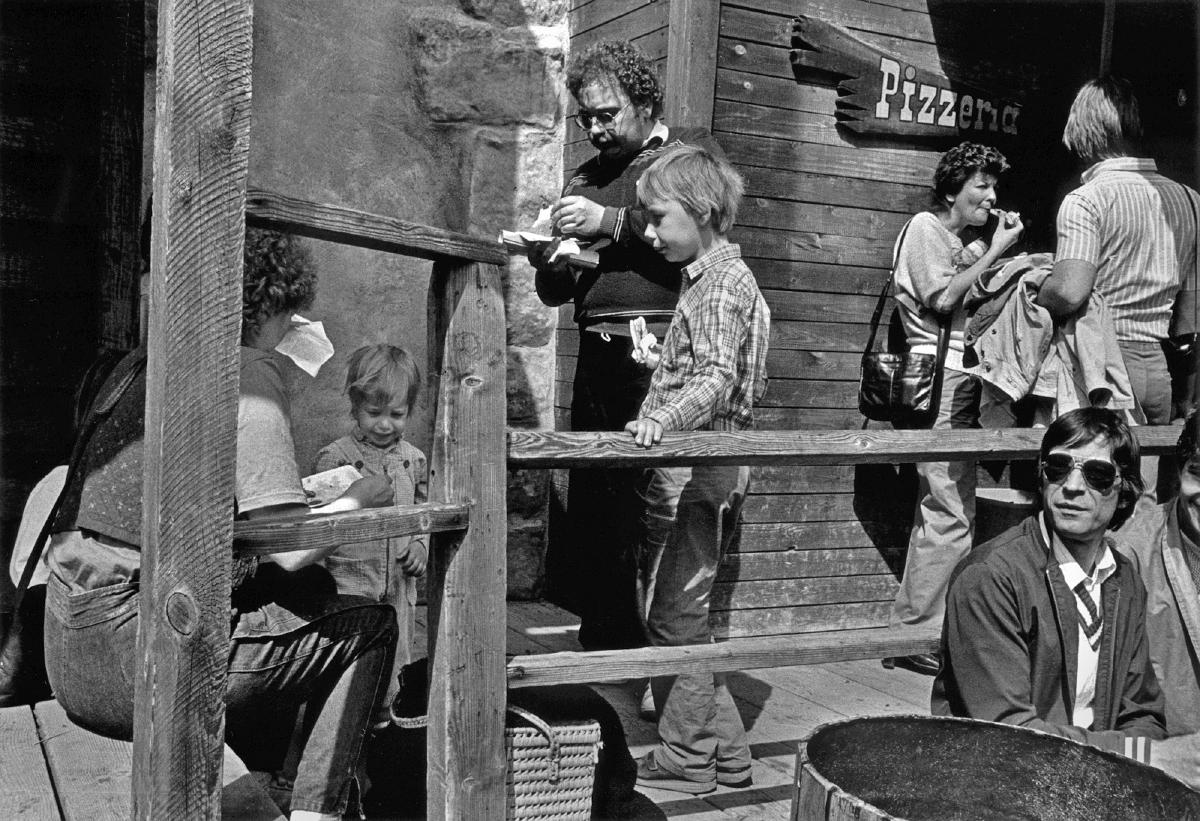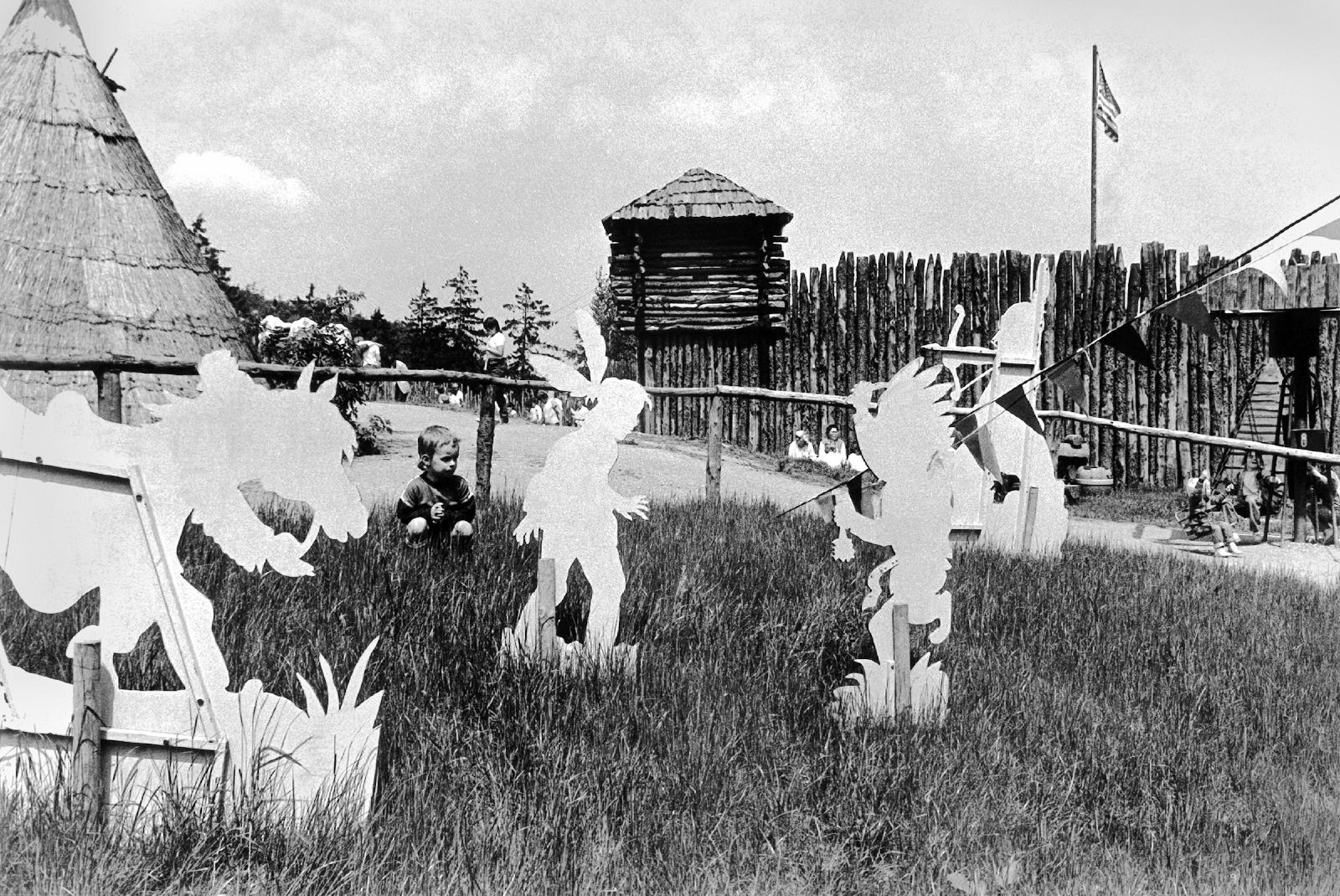Frontgarden of Illusions
“We stop living in a multi-dimensional world of reality, in a world. that allows all aspects of the human human personality, from its bone structure to its most delicate sensations, comes to play. In its place we have put…a second-hand world, a ghost world, in which everyone lives a second-hand life that is merely derivative….Images invade us so incessantly, so insistently, that we might as well be paralyzed as far as our own intentions are concerned, we might as well be paralyzed, so undesirable are our stirrings within ourselves.”
Lewis Mumford, A Second-Hand World (1952)
In the series Front Garden of Illusions Wolfgang Zurborn combined black&white photographs from amusement parcs in Germany with images from the Carnival in Cologne and parcs and front gardens in Dortmund and Castrop Rauxel.
Photographs from this work group were exhibited at Bayerische Staatslehranstalt für Photographie, München, 1986; at Landesbildstelle Hamburg, 1988 and at Haus der Photographie, Deichtorhallen Hamburg 2009. Some images were printed in the booklet accompanying the publication Playtime.
1985 Wolfgang Zurborn received the Otto Steinert - Preis der Deutschen Gesellschaft für Photographie
| Solo exhibitions | ||
|---|---|---|
| 2009 |
Drift – Fotografien 1980-2006 Haus der Photographie, Deichtorhallen, Hamburg, Germany |
|
| 1988 |
Freizeitparks und andere Fotografien 1981-1984 Landesbildstelle, Hamburg, Germany |
|
| 1986 |
Freizeitparks in Deutschland Bayerische Staatslehranstalt für Photographie, München, Germany |
|
| Group exhibitions | ||
|---|---|---|
| 2016 |
Bewegung im Blick Die Kölner Fotografenszene der 70er- und 80er-Jahre artrmx-Galerie, Köln, Germany |
|
| 2010 |
ÜberTage – Pixelprojekt Ruhrgebiet Kunstmuseum Mülheim, Germany |
|
| 2008 |
Pixelprojekt Ruhrgebiet Wissenschaftspark, Gelsenkirchen, Germany |
|
| 1982 |
52 junge deutsche Fotografen Galerie Gaiser, Weißenhorn, Germany (Katalog) |
|
Photographs from German Amusementparcs
by Wolfgang Zurborn
“In the past, an image was a rare symbol … Today it is the immediate experience that is rare. (Lewis Mumford, A Secondhand World)”
I feel in myself how deeply the images, e.g. on the TV screen or recorded in films, are stuck in me, and how they often prevent me from finding my own identity. I also know the feeling of how one’s own sensibility is shortened by reacting only to symbolic stimuli, by hardly perceiving reality in all its diversity. Nevertheless I cannot deny these image worlds, since they play an ever more important role in our time, our life is shaped by them.
I believe that it may sound strange at first to find images in amusement parks that tell us something about our “reality”. But what is it about this plastic world that makes you think you can go on a trip to Chinatown, Mexico and the Wild West? I’m reminded of a sentence by Günther Anders, who in his essay “Iconomania” in 1956: “What is real for the tourist is not St. Mark’s Square in Venice, but rather the one lying in his photo album.” We live in a society in which being is no longer defined by participating in something, by understanding it, but equates being with possession. Not real interest in the object is the motivation to take photographs, but rather the feeling that the picture makes the sight one’s own property. Thus it makes then also no more difference whether one consumes the “pictures of the world” as tourist in far countries, or, presented neatly by clever businessmen, in amusement parks.
The longer and more intensely I observe life in the parks, the way people seek entertainment and distraction, how they interact with each other, how they eat, and hear what they have to say to each other, the more I have to understand how deeply this consciousness intervenes in all areas of our lives. In this world, there is hardly any room left to develop one’s own imagination and love of life, to live out one’s personality in the manifold sense. The more perfect the parks are developed, the less they give us the opportunity to become active ourselves. Millions of Marks [editor’s note: currency before the EURO] are spent to build up dummies that pretend that we could escape from everyday life here. The motifs for these scenery landscapes are taken from a television world twhich creates myths in its images that are ultimately directed against people’s interests, since they are not based on real experiences, in fact no longer respond to reality at all. They lead a dangerous life of their own, since they have no other purpose than to be consumed.
The models for these theme parks come from Disneyland, and in Ronald Reagan’s America we can also follow, the spirit of Walt Disney is taking over all areas of public life, politics, sports, architecture and so on. Jürgen Leinemann writes in his article “Cinema of Emotions” about America before the election (1984): “The country is disguising itself into an urban science fiction small town flirting with history … Americans are in bright droves in retreat from reality.”

This summer, as I walked through the parks in Germany, which can boast millions of visitors each year, I also had the feeling that I was moving in a model for a society that has lost touch with reality and is becoming more and more alienated from itself. So it is also no coincidence that in almost all shows the computer-controlled puppets provide the entertainment. Their advantage is that they, never moody or tired, can constantly provide fun. But the further we take refuge in this artificial world, the less we can do with ourselves - a vicious circle that almost inevitably closes.
The first shots I took at Phantasialand showed a clear distance from the action. I reacted aggressively, because I sensed everywhere, in every detail, the spirit that had built up this dream world, characterized by small checkered thinking of order and clinical mania for cleanliness. Only the illusionary worlds are about liberation from social constraints. But the longer I photographed, the clearer it became to me that my motivation for taking photographs is not to take pictures that provide evidence for thoughts that help me to believe that I am above things. Rather, I am interested in understanding myself as a part of this world, and to see in the photographs reflections of my feelings towards it. I feel the urge to perceive again and again everyday scenes, because they tell the most about our fears, disappointments, desires and longings. Exactly this present, however, is increasingly lost in our consciousness, since, as Günther Anders wrote as early as 1956, it is degraded to a means for the “it will have been”, to something unreal and phantom-like. It seems as if hardly matters any more to the individual how life in the amusement parks presents itself, since in the end it is only about satisfying the need for images.
The photographs were taken in the amusement parks: Phantasialand (Brühl), Fort Fun (Bestwig), Tramlandpark (Bottrop), Holidaypark (Haßloch), Europapark (Rust).

